- Latest Version 1.128
- Version 1.126
- SAPUI Version 1.124
- SAPUI5 Version 1.122
- SAPUI5 Version 1.120
- SAPUI5 Version 1.118
- SAPUI5 Version 1.116
- SAPUI5 Version 1.114
- SAPUI5 Version 1.112
- SAPUI5 Version 1.110
- SAPUI5 Version 1.108
- SAPUI5 Version 1.106
- SAPUI5 Version 1.104
- SAPUI5 Version 1.102
- SAPUI5 Version 1.100
- SAPUI5 Version 1.98
- SAPUI5 Version 1.96
- SAPUI5 Version 1.94
- SAPUI5 Version 1.92
- SAPUI5 Version 1.90
- SAPUI5 Version 1.88
- SAPUI5 Version 1.86
- SAPUI5 Version 1.84
- SAPUI5 Version 1.82
- SAPUI5 Version 1.80
- SAPUI5 Version 1.78
- SAPUI5 Version 1.76
- SAPUI5 Version 1.74
- SAPUI5 Version 1.72
- SAPUI5 Version 1.70
- SAPUI5 Version 1.68
- SAPUI5 Version 1.66
- SAPUI5 Version 1.64
- SAPUI5 Version 1.62
- SAPUI5 Version 1.60
- SAPUI5 Version 1.58
- SAPUI5 Version 1.56
- SAPUI5 Version 1.54
- SAPUI5 Version 1.52
- SAPUI5 Version 1.50
- SAPUI5 Version 1.48
- SAPUI5 Version 1.44
- SAPUI5 Version 1.42
- SAPUI5 Version 1.40
- SAPUI5 Version 1.38
- SAPUI5 Version 1.36
- SAPUI5 Version 1.34
- SAPUI5 Version 1.32
- SAPUI5 Version 1.30
- SAPUI5 Version 1.28
- SAPUI5 Version 1.26
- Latest Version 1.128
- Version 1.126
- SAPUI Version 1.124
- SAPUI5 Version 1.122
- SAPUI5 Version 1.120
- SAPUI5 Version 1.118
- SAPUI5 Version 1.116
- SAPUI5 Version 1.114
- SAPUI5 Version 1.112
- SAPUI5 Version 1.110
- SAPUI5 Version 1.108
- SAPUI5 Version 1.106
- SAPUI5 Version 1.104
- SAPUI5 Version 1.102
- SAPUI5 Version 1.100
- SAPUI5 Version 1.98
- SAPUI5 Version 1.96
- SAPUI5 Version 1.94
- SAPUI5 Version 1.92
- SAPUI5 Version 1.90
- SAPUI5 Version 1.88
- SAPUI5 Version 1.86
- SAPUI5 Version 1.84
- SAPUI5 Version 1.82
- SAPUI5 Version 1.80
- SAPUI5 Version 1.78
- SAPUI5 Version 1.76
- SAPUI5 Version 1.74
- SAPUI5 Version 1.72
- SAPUI5 Version 1.70
- SAPUI5 Version 1.68
- SAPUI5 Version 1.66
- SAPUI5 Version 1.64
- SAPUI5 Version 1.62
- SAPUI5 Version 1.60
- SAPUI5 Version 1.58
- SAPUI5 Version 1.56
- SAPUI5 Version 1.54
- SAPUI5 Version 1.52
- SAPUI5 Version 1.50
- SAPUI5 Version 1.48
- SAPUI5 Version 1.46
- SAPUI5 Version 1.44
- SAPUI5 Version 1.42
- SAPUI5 Version 1.40
- SAPUI5 Version 1.38
- SAPUI5 Version 1.36
- SAPUI5 Version 1.34
- SAPUI5 Version 1.32
- SAPUI5 Version 1.30
- SAPUI5 Version 1.28
- SAPUI5 Version 1.26
Tile
Intro
A tile is a container that represents an app on the SAP Fiori launchpad home page. All apps have at least one corresponding tile. The only exception is the factsheet, although users also have the option of saving factsheets as tiles.
Tiles are used to display and launch apps on the launchpad. Therefore, do not use them on an overview page or anywhere else.
Tiles can display different types of content. They can contain an icon, a title, an informative text, numbers, and charts. The information shown is based on data supplied by the app, such as key performance indicators (KPIs).
Users can personalize their home page by selecting the tiles for the apps they want to use from the app finder. The apps available in the app finder depend on the user’s role.
The number of visible tiles on the launchpad home page depends on the screen resolution. If the tiles in a group do not fit in one row, they are wrapped to the next row. The tiles also appear smaller on small screens.
Layout
The generic tile control currently supports two tile sizes (one for size S, and one for larger screens) and two tile dimensions (1 x 1 and 2 x 1). The layout of the generic tile is fixed, with designated areas for the header, content area, and footer. The control supports two modes: header mode and content mode. When header mode is chosen, the tile gains two lines of header text to describe the application or navigation target more precisely.
Header mode = 4 lines headline, 1 line subtitle, no content area, footer area
Content mode = 2 lines headline, 1 line subtitle, content area, footer area
Header Area
The header area is mandatory, and contains the header and an (optional) subtitle. The header is always in the upper left corner of the tile, except on feed tiles.
Texts in the Header Area
- Mandatory header
The header can have up to two lines of text before it is truncated. - Optional subtitle
The subtitle can have one line of text before it is truncated. - Condition
A total of three lines is available for the title and subtitle (two for the header and one for the subtitle).
Content Area
The content area is not mandatory. The content itself is defined by the apps and can comprise KPIs, charts, texts, or icons. Only show content types that are described on this page. Do not use custom icons.
Tip: If you are not showing a KPI or a chart, try to show an icon instead to help users to distinguish the tiles.
Footer Area
The status area is an optional, text-only area, and cannot display any other content.
Types
KPI Tile
Key performance indicators (KPIs) are used to measure and monitor a company’s performance at a strategic and operational level.
The tile displays the KPI values as large, easy-to-recognize digits. In addition, you can show deviation arrows, negative values, and scaling factors. You can also use semantic colors to emphasize the content. The number of digits is limited by the size of the tiles.
You can use the 2 x 1 tile to combine the content of two tiles into one. For example, you can show a KPI next to a comparison chart (as shown on the right), or use any other combination such as KPI/KPI, chart/chart, and so on. You can show different information in both the content and status areas. However, in all other respects, the 2 x 1 tile behaves as one tile – with one headline, subtitle, clickable area, and target.
A bullet chart is a variation of a bar chart. It compares a single, primary value to one or more target values. The primary value is shown in the context of qualitative ranges (thresholds) such as poor, satisfactory, and good.
See the image on the right for examples of different bullet charts:
- The chart on the left focuses on the actual value in relation to the target value and the forecast.
- The chart in the middle shows the same combination, but without the forecast.
- The chart on the right focuses on the delta between the actual value and the target value. Note that the delta visualization never shows the forecast.
All the charts show certain thresholds to give the user a sense of orientation.
You can use trend charts (also known as area charts) to show cumulated totals over time, based on amounts or percentages. In this example, you can see a stacked trend chart. You can also use trend charts to depict trends for related attributes.
The trend chart is similar to the plot chart, except that the area below the plotted line is colored to indicate the volume.
SAP Jam Tile
If an organization uses SAP Jam, users can also add SAP Jam tiles to the launchpad. The SAP Jam tile shows the content of new notifications in 10-second intervals. It can scroll through up to 10 new notifications. Tile content is updated every five minutes. If there are no new notifications, the tile displays the most recent notification. If the 2 x 1 tile does not contain an icon, the headline uses the full length of the container. For more information, see collaboration.
Feed Tile
The feed tile is a special tile that shows a news feed. It refreshes every three to five seconds and is twice the size of a standard tile. In addition to the news headline, it comes with a background image, the news source, and a time stamp. The feed tile flips through news messages, which are configured for the tile. For accessibility reasons, the tile contains a start and pause button which can be found by hovering the mouse over the tile on desktop devices. On touch devices, the buttons are always displayed. Additionally, the number of slides contained the tile is visualized as dots on on the bottom of the tile.
Behavior and Interaction
All tiles on the SAP Fiori launchpad support one click event and one navigation target.
Styles
Tile Loading
When a tile is loading, the standard loading indicator appears in the center of the tile. The tile itself is overlayed in white.
If a tile cannot be loaded, a warning icon and text appear at the bottom of the tile. Error messages should not be displayed in the status area. For each tile, the error text can be defined individually by the system administrator when preparing the tile.
The darker shade of gray and the dotted line indicate the pressed state. The dotted line also indicates the focused state.
Default, Hover, Pressed State
Guidelines
Do’s
- Use only this control.
- In the content area, only show content described in this guideline. (For example, do not play videos or animations or gifs in the tiles)
Don’ts
- Do not use the standard tile (sap.m.StandardTile) or custom tile (sap.m.CustomTile). These are deprecated.
- Do not use the status area for error messages.
- Do not use icons on KPI tiles; only use icons on basic launch tiles or monitoring tiles.
- Do not show icons next to an counter when you expect 5 digits or more.
Icons
- We have decided to stop unique launch icons being created for individual apps. Creating a unique icon for every app was and is not scalable in terms of iconography and production (hinting and PNG exportation).
- Projects without a SAP Fiori ID do not get an individual icon.
- Do not develop your own icons or use custom icons.
Resources
Want to dive deeper? Follow the links below to find out more about related controls, the SAPUI5 implementation, and the visual design.

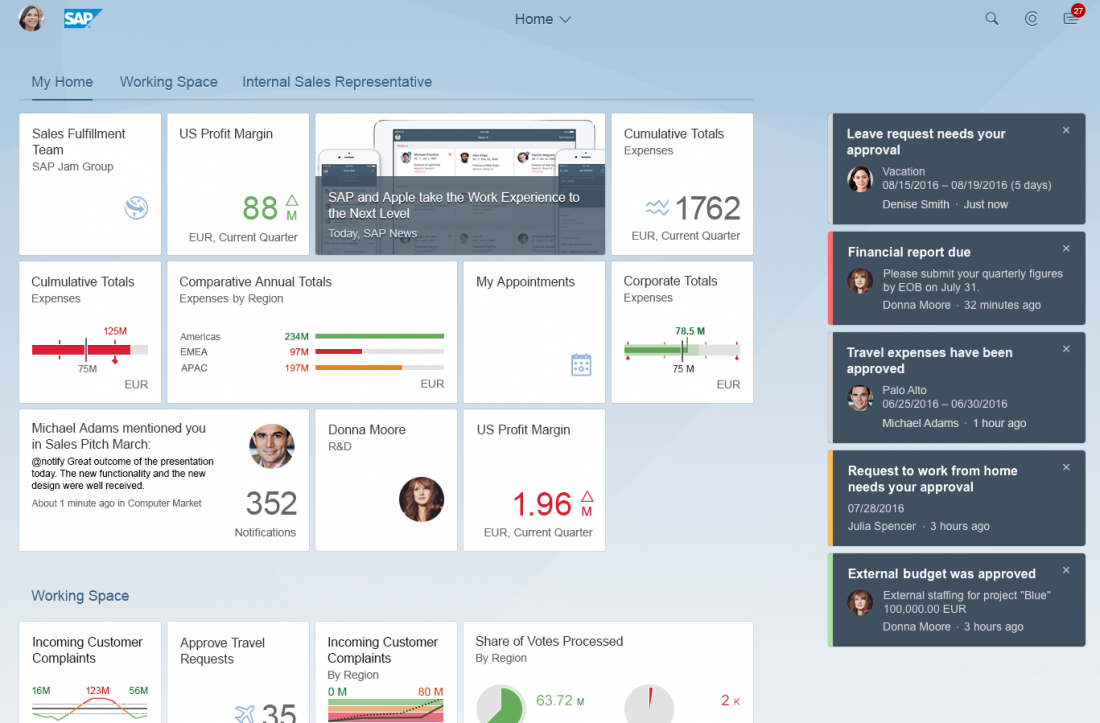

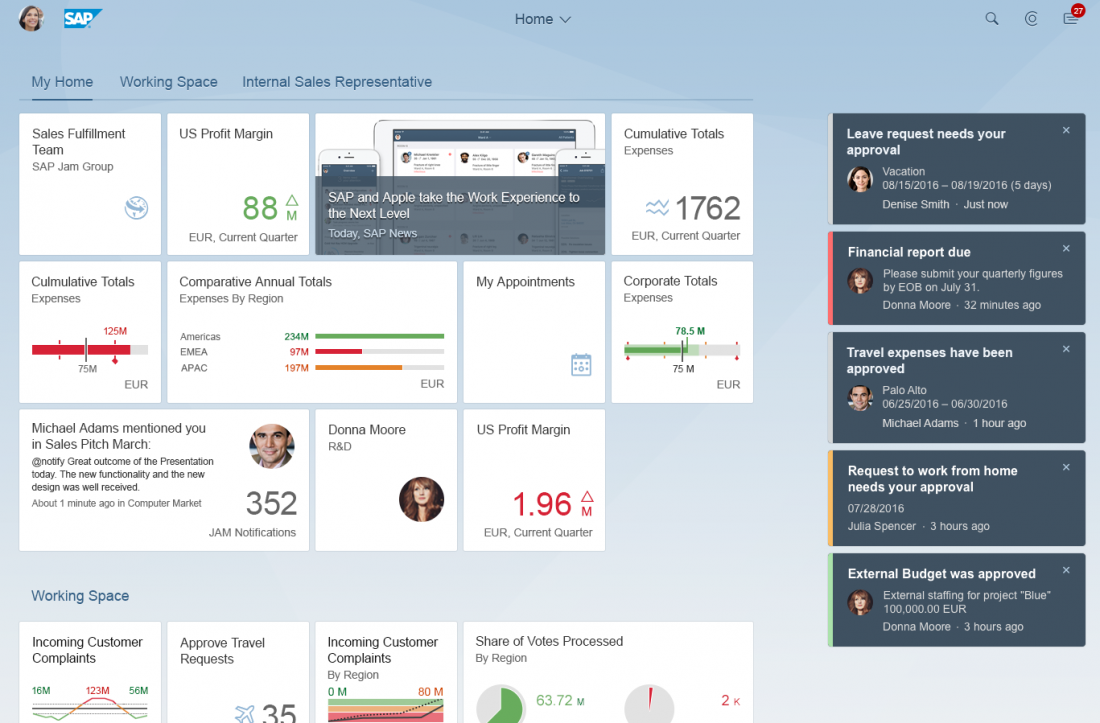
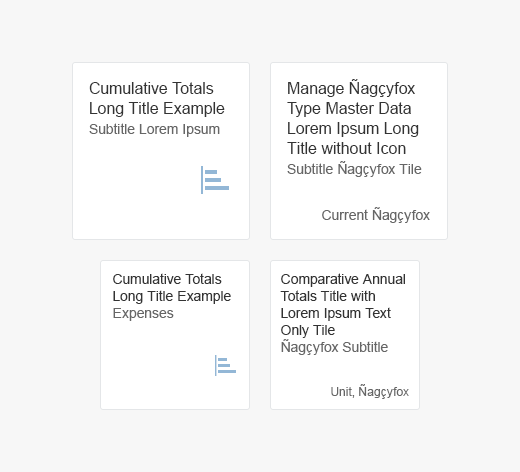


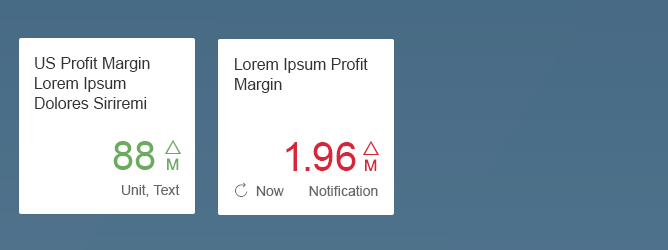

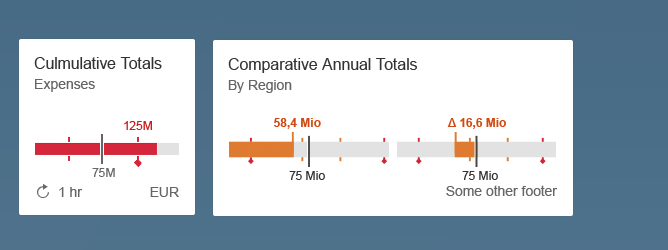




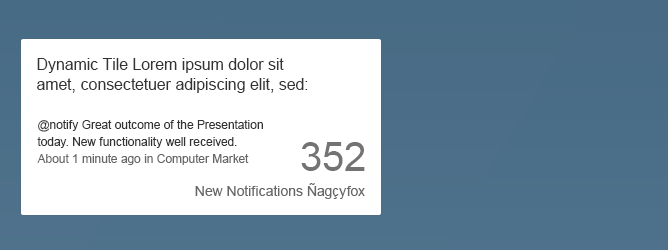
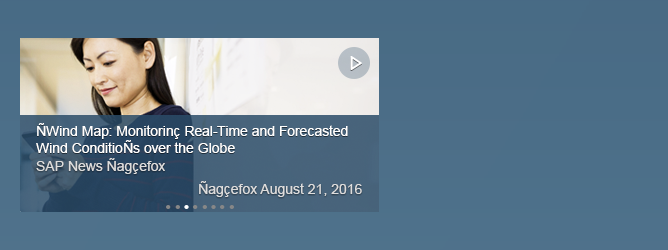
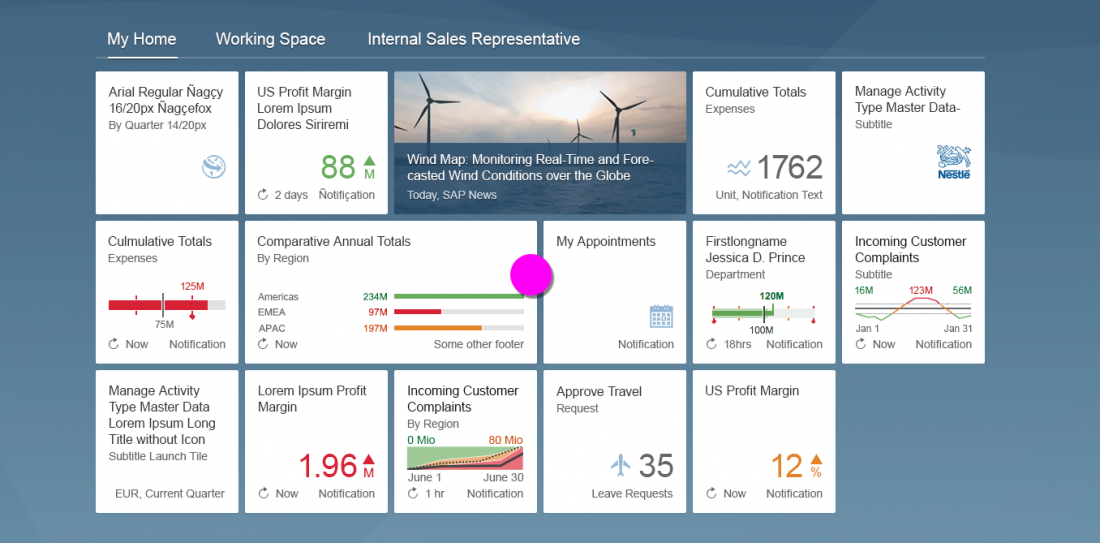

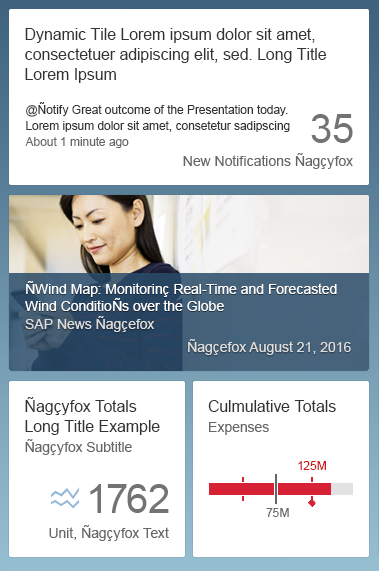
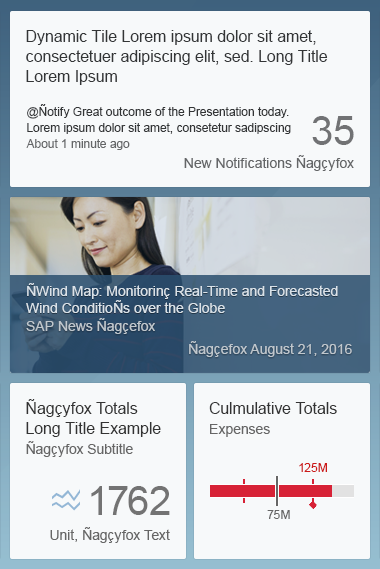
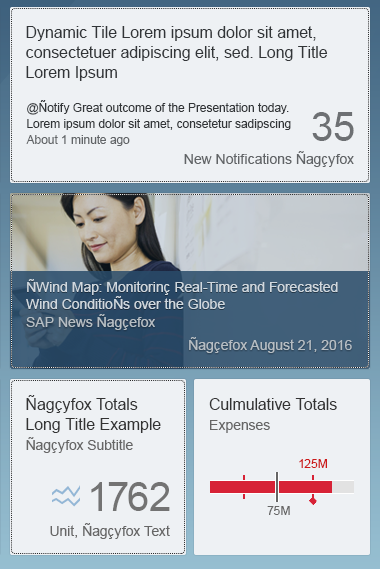
 Your feedback has been sent to the SAP Fiori design team.
Your feedback has been sent to the SAP Fiori design team.